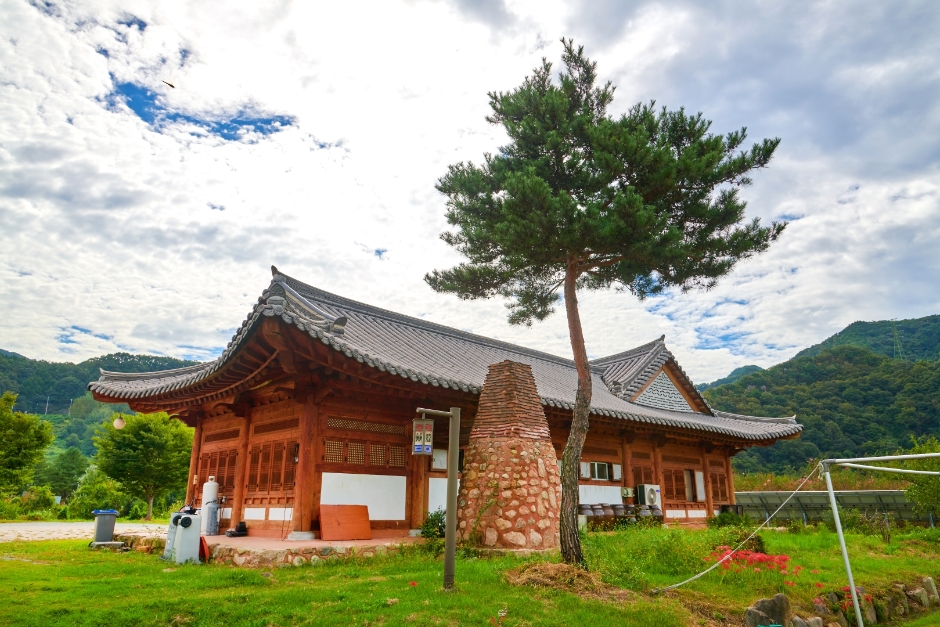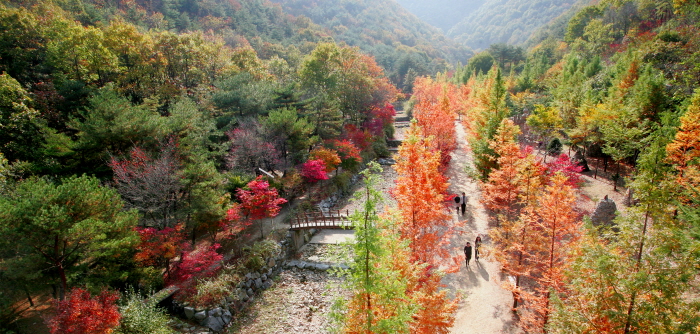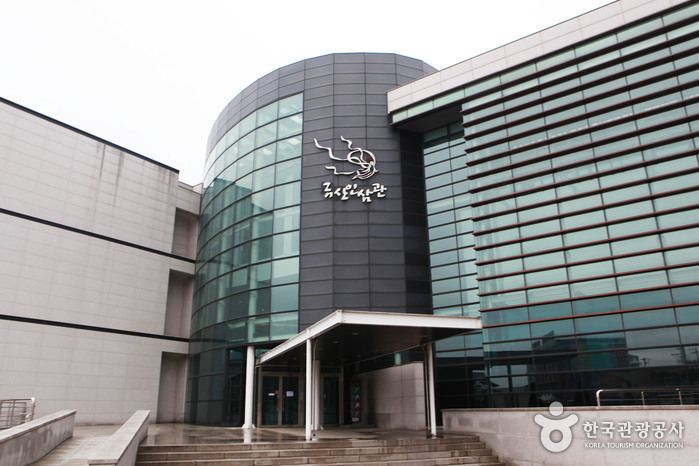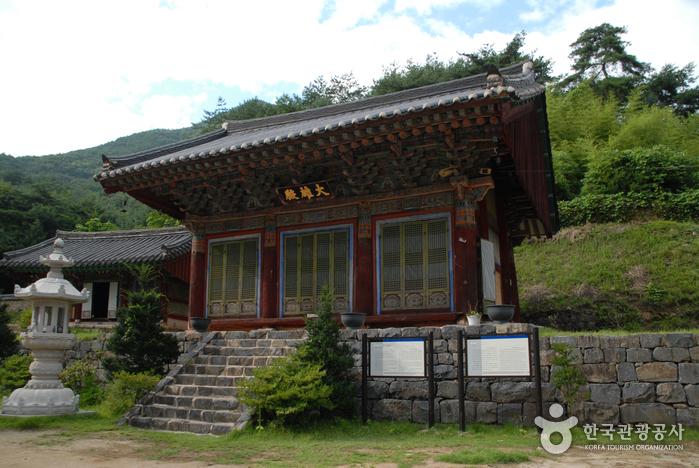Gosan Changpo Village (창포마을)
17.7Km 2025-10-23
385 Daeajeosu-ro Gosan-myeon, Wanju-gun, Jeollabuk-do
Since there is a colony of irises (Changpo), it is a quiet rural village that produces traditional handmade products using irises. Various experiences such as making natural shampoo and soap are available. It is essential to take a picture in a pose like a pictorial at the rustic concrete bridge where the BTS members sat, and the old shop Yongam Sanghoe where you can feel the years.
Geumsan Ginseng Market (금산인삼약령시장)
17.8Km 2024-08-22
24 Insamnyakcho-ro, Geumsan-gun, Chungcheongnam-do
+82-41-753-3219
Geumsan is widely known as the largest ginseng market in Korea, holding 80% of the nation’s ginseng trade. Along with its enormous ginseng industry, Geumsan is also rising as the largest herbal medicine market in the country. The Geumsan Ginseng & Herbal Medicine Market is a traditional market with a long-standing history, offering a variety of health products at its international market, Susam Center, Ginseng Medicinal Market, and shopping center. Merchants and consumers from all over the country gather at the Geumsan Market on the 2nd, 7th, 12th, 17th, 22nd and 27th of every month starting early in the morning.
Geumsan Wonjo Kim Jeongi Samgyetang (금산원조김정이삼계탕)
17.8Km 2024-12-27
충청남도 금산군 금산읍 인삼약초로 33
041-752-2678
This restaurant serves samgyetang made with ginseng purchased directly from Geumsan Ginseng Market. Made by simmering chicken with dried jujube, cheongung (cnidium), and other ingredients for an hour, this chicken soup has a large following among not only the locals but also the merchants and customers that visit the Geumsan Ginseng Market. You can also try samgyetang, made with other ingredients, such as abalone, shingled hedgehog, and cordyceps.
Sangso-dong Forest Park (상소동 산림욕장)
17.8Km 2022-12-26
San 1-1, Sangso-dong, Dong-gu, Daejeon
+82-42-251-4771
Sangso-dong Forest Park is located at the point where the foothills of Maninsan Mountain and Sikjangsan Mountain meet. The road to the park is beautifully lined with sycamore trees. The park offers various facilities for enjoying nature and in particular, the stone pagodas placed throughout the park are a must-see. Visitors can stack their own rocks and make wishes relating to family, health, relationships, and more. The park is great for walks, hikes, or even just to relax as wild flowers bloom all throughout spring to fall.
Jinjamhyanggyo Confucian School (진잠향교)
17.9Km 2022-12-26
67, Gyochon-ro, Yuseong-gu, Daejeon
+82-42-543-1811
Jinjamhyanggyo Confucian School was established to enshrine and orient the ancestral tablet of excellent classical scholars in 1405 (the 5th year of King Taejong's reign) and to educate people. More detailed information is not available in the record. The remaining building is called Daeseongjeon, and the ancestral tablets are 5 Seong, Songju 6 hyeon, and Korean 18 hyeon. One instructor, who received a plot of land and slaves from the nation, taught 30 students during the Joseon period, but after the Gapo Reform, the educational function disappeared and Seokjeon, a religious ceremony, was served in summer and fall with offerings of incense on the first day of each month and at the half-moon instead. Daeseongjeon (Cheongju Daeseong High School (Former Main Building of Cheongju Commercial High School) is designated as a Registered Cultural Heritage.
Sunshine Land (선샤인랜드)
18.0Km 2024-07-09
102 Bonghwang-ro, Yeonmu-eup, Nonsan-si, Chungcheongnam-do
Sunshine Land is a cultural complex located in Nonsan, Chungcheongnam-do. One can experience and observe diverse content at this themed attraction, which is divided into four sections: Survival Experience Center, Military Experience Center, Sunshine Studio, and 1950 Studio. The Survival Experience Center and Military Experience Center incorporate VR technology for an interactive and realistic entertainment. The Sunshine Studo and 1950 Studio are decorated in the theme of the aftermath of the Korean War, allowing one to get a glimpse and knowledge of what life in Korea was like after the war.
Geumsan Ginseng Museum (금산인삼관)
18.1Km 2024-08-22
30 Insamgwangjang-ro, Geumsan-gun, Chungcheongnam-do
+82-41-750-2621
Geumsan Ginseng Museum was founded to spread the excellence of Korean (Geumsan) ginseng across the nation and the world. Ginseng cultivation implements and models, efficacy, foods, and other products containing ginseng are on display in this museum. Visitors can also watch ginseng-related videos to gain a better understanding of Korean ginseng.
Daejeon O-World (대전오월드)
18.2Km 2022-12-27
70, Sajeonggongwon-ro, Jung-gu, Daejeon
+82-42-580-4820
Daejeon O-World was established when the Daejeon Zoo and Joy Land, an amusement park, were integrated under the supervision of the Daejeon City Corporation. The project cost a whopping 40 billion won and resulted in the construction of Flower Land (100,000㎡) in addition to the renamed Zoo Land and the preexisting Joy Land. It opened on May 1, 2009 to the public.
The three main sections of Daejeon O-World are Zoo Land, Joy Land, and Flower Land. Zoo Land is currently home to a total of 600 animals of 130 different species including American black bears, Bengal tigers, lions, elephants, giraffes, zebras, and ostriches. Amusement rides, waterslides, and four-season sledding are housed at Joy Land. Flower Land boasts a number of smaller sections such as Rose Garden, Four Season Garden, Herb Garden, and Maze Garden and is home to a total of 150,000 tress of 100 different species and 200,000 flowers of 85 different species. An outdoor stage and concert hall are also located in the area.
There are plenty of things to see and enjoy in every corner of Daejeon O-World. Just beyond Festival Street, visitors will find a large (3,000㎡) pond with a fountain.
Geumsan World Insam Festival (금산세계인삼축제)
18.2Km 2025-07-09
30 Insamgwangjang-ro, Geumsan-gun, Chungcheongnam-do
+82-41-750-2319
The Geumsan World K-Insam Festival is a well-being event that promotes the excellence of ginseng, an herb that strengthens the immune system against cancer and other diseases. Visitors can take part in health-related programs, including the red ginseng foot bath, Korean medicine therapy, and traditional massage at the Health Experience Hall. Visitors can also try foods made with ginseng and check out the various shapes that the medicinal plant comes in and its uses, including makgeolli (unrefined rice wine) and fries. There are booths for a wide variety of activities, such as ginseng harvesting and ginseng art, as well as performances that introduce Geumsan’s culture and traditions. Geumsan ginseng can also be purchased at a cheaper price at the festival’s market, and its goods can be received directly from within the county.
◎ Geumsan Ginseng
Geumsan Insam Herbal Medicine Market deals with 80% of Korea’s total ginseng production.
Geumsan Boseoksa Temple (보석사 (금산))
18.2Km 2021-11-29
30, Boseoksa 1-gil, Geumsan-gun, Chungcheongnam-do
+82-41-753-1523
Located on the southeastern slope of Jinaksan Mountain (732 meters), about six kilometers away from Geumsan-eup, Boseoksa Temple was founded by the great Buddhist monk Jogu Daesa in 866 (12th year of King Heongang) during the Silla Kingdom. The temple’s name Boseoksa (boseok meaning jewelry) comes from the statue of Buddha in the temple that was cast from gold found in the mountain facing the temple.
The temple is comprised of Daeungjeon Hall, Euiseongak Shrine and Sansingak Shrine. Close to the temple grounds are 12 stunning waterfalls. Visitors can also see a 1,100 year-old ginkgo tree or take a pleasant stroll along a 300-meter long fir tree road.





 English
English
 한국어
한국어 日本語
日本語 中文(简体)
中文(简体) Deutsch
Deutsch Français
Français Español
Español Русский
Русский